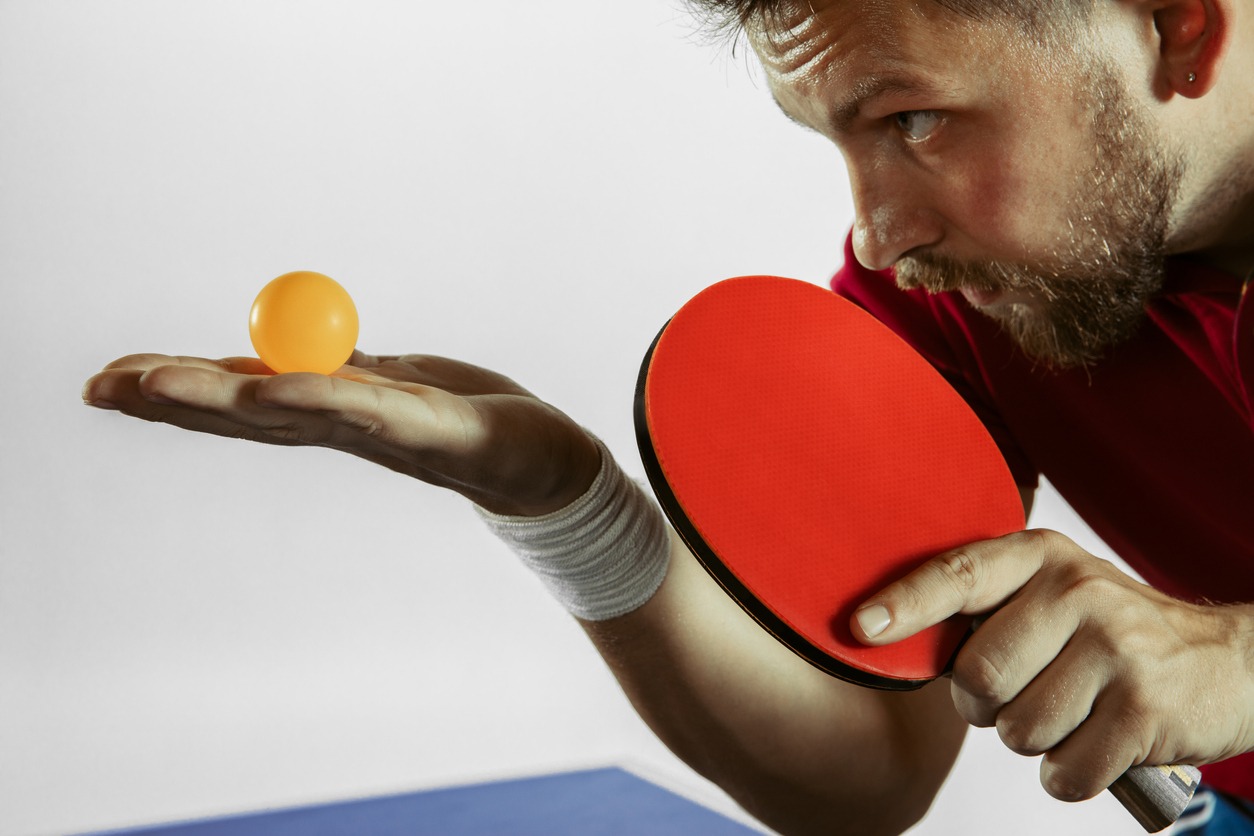Ping pong, a beloved sport enjoyed by millions worldwide, may seem simple at first glance, but it’s a game of precision, speed, and strategy. Whether you’re a novice or an experienced player, making common mistakes is part of the learning process.
Understanding our ping pong mistakes is like having a guide to improve our game. It’s like spotting where we go wrong and learning not to do it again. Think of it as fixing a broken toy; once you know what’s wrong, you can make it work better. In ping pong, spotting our mistakes helps us play better and win more. It’s the secret to becoming a ping pong champ!
In this article, we’ll discuss the seven most common errors made by ping pong players and provide professional tips on how to correct them. Let’s dive in!
1.Grip and Stance:
Holding the paddle incorrectly in ping pong.
Holding the paddle incorrectly affects your control and accuracy, making it challenging to execute shots effectively. It’s a fundamental mistake that can hinder your overall performance.
To correct this mistake, focus on your grip and stance:
- Grip: There are two main types of grips in ping pong – the shakehand grip and the penhold grip. Regardless of the grip, ensure that your fingers are relaxed, and you’re not gripping the paddle too tightly. This relaxed grip allows for better wrist movement and control.
- Stance: Your stance is the foundation of your game. Bend your knees slightly to stay agile and ready to move. Distribute your weight evenly between both legs. This balanced stance ensures stability and mobility, enabling you to reach and return shots effectively.
2. Ball Placement and Timing:
Hitting the ping pong ball without considering its placement on the table.
This mistake results in a lack of precision and control over your shots. When players prioritize power over accuracy, they often miss their target, making it easier for opponents to counter their moves. It can lead to losing points and games.
To correct this common ping pong mistake, it’s vital to work on ball placement and timing:
- Ball Placement: Instead of focusing solely on power, practice aiming for specific spots on the table, such as the corners and edges. This precision makes it difficult for your opponent to return the ball effectively. By consistently targeting specific areas, you can exert greater control over the game and create opportunities for scoring points.
- Timing: Rushing your shots is a mistake. Instead, take the time to read your opponent’s movements and anticipate the ball’s trajectory. This involves observing their paddle angle, body positioning, and any cues they may give. By understanding your opponent’s intentions, you can better position yourself to make successful shots. Timing is crucial to executing shots with accuracy and ensuring they land where you want them to.
3. Lack of Footwork:
Neglecting effective footwork in ping pong.
Overlooking the importance of footwork leads to sluggish movements and an inability to reach the ball efficiently. When players stand still or fail to adjust their positions swiftly, they become more prone to making errors and are at a disadvantage during rallies.
To rectify the common mistake of lacking proper footwork in ping pong, you need to focus on your agility and movement:
- Agility Drills: Incorporate agility drills into your practice routine. These drills enhance your ability to move swiftly and make quick adjustments during gameplay. Exercises like ladder drills and cone drills can help improve your footwork, making you more agile and responsive on the table.
- Quick Movement Between Shots: Practice moving quickly between shots. Being prepared to reposition yourself after each shot is crucial. This readiness allows you to maintain your balance and be in an optimal position to return your opponent’s shots effectively. Work on your split-step technique, which involves a small jump and landing with your feet shoulder-width apart, ready to move in any direction.
- Anticipate and Adjust: Pay close attention to your opponent’s shot placement and be proactive in anticipating where the ball will go. Adjust your position accordingly to ensure you’re in the right place to return the shot with control and accuracy. This proactive approach reduces the likelihood of making errors due to poor positioning.
4. Too Close to the Table:
Standing too close to the table in ping pong.
When you stand too close to the table, you limit your ability to return balls that land deep on your side of the table. This positioning leaves you with insufficient space to execute a proper stroke, often resulting in errors and missed shots. It can also make it challenging to adapt to varying ball placements and styles of play from your opponent.
To address the mistake of standing too close to the table, it’s essential to maintain the right distance and adapt your positioning:
- Create Space: Position yourself approximately 30cm-50cm away from the table. This distance provides ample room to handle balls that land deep on your side. It also allows you to maintain better court awareness and react to different shots effectively.
- Step In and Out: If the ball is returned very short, you can step closer to the table to reach it comfortably. However, after playing your shot, remember to step back to your ideal position. This dynamic movement ensures you’re always at an optimal distance from the table, ready to respond to various ball placements.
5. Overreliance on One Shot:
Overreliance on a single shot in ping pong.
Relying too heavily on one particular shot makes your gameplay predictable. When opponents know what to expect, they can easily counter your moves, reducing your effectiveness on the table. This mistake can lead to frustration and a higher likelihood of losing matches.
To address the common mistake of overreliance on one shot in ping pong, it’s crucial to diversify your repertoire and become a more versatile player:
- Practice Different Spins: Explore different spin techniques such as topspin, backspin, and sidespin. Each spin has unique characteristics and can be used strategically to control the ball’s trajectory and confuse your opponent. Incorporate spin variations into your shots to keep your gameplay unpredictable.
- Master Looping: The loop is a versatile shot that can be adapted for various situations. Practice looping against topspin, backspin, and float balls to develop a well-rounded offensive game. Looping allows you to attack aggressively and maintain control over rallies.
- Work on Smashes: Incorporate smashing into your game. A well-executed smash can be a game-changer, especially when your opponent provides a high ball. Practice both forehand and backhand smashes to become proficient in this powerful offensive shot.
- Change Up Your Strategy: Be mindful of your shot selection during matches. Avoid falling into the habit of using the same shot repeatedly. Instead, strategically choose shots that exploit your opponent’s weaknesses and keep them guessing about your next move.
- Adapt to Your Opponent: Pay attention to your opponent’s playing style and adjust your shots accordingly. If they struggle with a particular type of spin or shot, exploit that weakness. Being adaptable and flexible in your approach is key to becoming a more formidable player.
6. Ignoring Spin and Spin Recognition:
Ignoring the spin on the ping pong ball.
Neglecting to acknowledge and adapt to the spin on the ball leads to missed shots and errors. Spin drastically alters the trajectory and behavior of the ball, and failing to recognize it puts you at a significant disadvantage during a match.
To address the common mistake of ignoring spin and improve spin recognition in ping pong, consider the following strategies:
- Observe Paddle Angle: Pay close attention to your opponent’s paddle angle when they strike the ball. The angle of the paddle at contact indicates the type and direction of spin applied to the ball. For instance, a closed paddle angle suggests topspin, while an open angle indicates backspin. By recognizing these cues, you can anticipate the ball’s behavior.
- Wrist Movement: Focus on your opponent’s wrist movement during their shots. A flicking or snapping motion of the wrist can generate extra spin. This subtle but crucial detail can give you valuable information about the spin’s intensity and direction. By observing your opponent’s wrist, you can better prepare for the incoming spin.
- Practice Spin Variations: Work on your own spin variations during practice sessions. Experiment with different spins, including topspin, backspin, and sidespin, to become familiar with their characteristics. This hands-on experience will enhance your ability to recognize and adapt to spin during actual matches.
- Anticipate the Bounce: Try to predict how the ball will behave after it bounces on your side of the table based on the incoming spin. Adjust your position and racket angle accordingly to prepare for the ball’s trajectory and spin. Anticipation is key to making precise and effective returns.
- Stay Calm and Focused: Don’t let the spin on the ball fluster you. Stay composed and focused on tracking the ball’s movement. With practice, you’ll develop the ability to read spin cues quickly and make split-second adjustments.
7. Mental Fortitude:
Underestimating the importance of mental fortitude in ping pong.
Neglecting mental strength can lead to anxiety, frustration, and impatience during matches. These emotional hurdles can manifest as errors on the table, impacting your performance and decision-making. A weak mental game can hinder your ability to maintain focus and composure during critical moments.
To address the often-overlooked aspect of mental fortitude in ping pong, it’s crucial to nurture your mental game:
- Practice Mindfulness: Train your mind to stay in the present moment. When you’re mindful, you’re less likely to dwell on past mistakes or worry about future outcomes. This mental clarity enables you to focus on each point as it unfolds, reducing the chances of making errors due to mental distractions.
- Cultivate Calmness Under Pressure: Ping pong can be intense, especially during tight matches. Practice remaining calm and composed, even in high-pressure situations. This mental resilience allows you to make rational decisions and execute shots with precision when it matters most.
- Visualization: Incorporate visualization techniques into your training regimen. Close your eyes and vividly imagine successful shots, rallies, and match scenarios. This mental rehearsal can boost your confidence and improve your ability to execute shots flawlessly during actual play.
- Positive Self-Talk: Monitor your self-talk during matches. Replace negative or self-critical thoughts with positive affirmations. Believing in your abilities and maintaining a positive mindset can help you stay focused and reduce errors caused by self-doubt.
- Set Realistic Expectations: Avoid setting unrealistic expectations for yourself. Acknowledge that making mistakes is a natural part of the game. Embrace errors as opportunities for growth rather than dwelling on them as failures.
- Stay Resilient: Ping pong, like any sport, has its ups and downs. Stay resilient in the face of setbacks. Use mistakes as learning experiences and motivation for improvement. A strong mental game enables you to bounce back quickly from errors.
Conclusion
In the dynamic world of ping pong, honing your skills and minimizing mistakes is the path to mastery. Whether it’s perfecting your grip and stance, sharpening your ball placement and timing, mastering footwork, diversifying your shots, or fortifying your mental game, each facet plays a pivotal role in elevating your performance. The key takeaway is clear: recognize, address, and learn from your mistakes. Embrace the journey of improvement, for in these refinements lies the power to become a formidable ping pong player, capable of navigating the table with precision, adaptability, and mental strength. By understanding and rectifying these common errors, you transform them into stepping stones toward success in the exhilarating world of ping pong.


